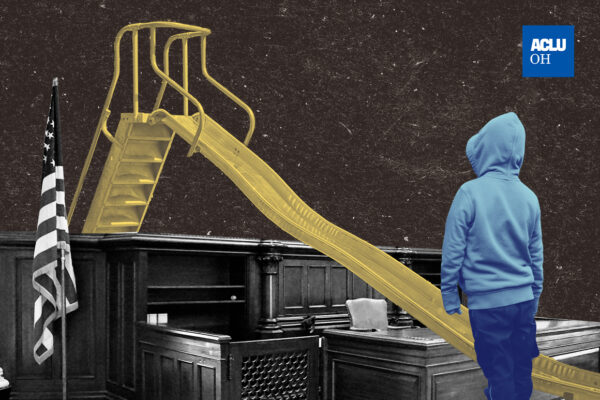As a person in my mid-20s, I often still feel like a kid. It feels like just yesterday that I was taking field trips, riding school buses, and running through a park. And if I asked several people when my childhood ended, I would most likely receive several different answers. Some would probably say 18 years old, others may say 21 years old, and rental car companies would tell me 25 years old.
In reality, the end of childhood is actually subjective. Although the legal definition of a child is “a person under eighteen years of age,” the duration of childhood varies. It can be determined by resources, opportunities, and even race. Studies have shown that Black children are more likely to be deprived of childhood and treated like adults at an earlier age than their white peers due to adultification bias. In the State of Ohio, the end of childhood can also be determined by the criminal legal system through a process known as bindover.
A bindover occurs when a “juvenile court in Ohio transfers jurisdiction of a child to the adult court for criminal prosecution.” This process, which can be either mandatory or discretionary1, treats children as young as 14 years old like adults by transferring them to adult court to face adult penalties.
Think about some of the decisions you made at 14. Does your skin crawl with embarrassment? Do you chuckle and think “what was I thinking?” or do you shrug it off blaming it on immaturity and naiveté? The answer is probably yes to each of those questions because you’re right. It is likely that you occasionally failed to make rational decisions because the brain is not finished developing until your mid-20s.
Research on adolescent brain development has established that children are fundamentally different from adults. Children are more likely to be impulsive, susceptible to peer pressure, and sensation seeking. In recent years, the United States Supreme Court has even used this research to inform several decisions about youth sentencing. Yet, the State of Ohio continues to ignore the science and treat children like adults.
Every year, Ohio transfers nearly 200 children to the adult system - effectively ending childhood for many of Ohio’s youth. The vast majority of these youth are Black and brown. More specifically, 80% of the youth transferred are Black. In fact, Ohio is ranked among the top five states that disproportionately transfer youth of color. While some may attempt to hastily argue that this is because Black children commit more crimes than their peers, statistics have repeatedly shown that Black and white children commit crimes at similar rates. However, Black children are treated differently at “every point of contact with the justice system,” which leads to disparate outcomes in sentencing and incarceration.
Cuyahoga County, in particular, leads the state in the rate of bindovers and racial disparities in the bindover process. Cuyahoga County transfers more children to adult court than Franklin, Hamilton, Montgomery, and Summit counties combined. This is a direct result of prosecutorial discretion. In Ohio, charges brought against a child are determined by prosecutors, and certain charges can make a child eligible for a bindover. A prosecutor can choose to aggressively charge and use the highest offense possible whether it is the best fit for the alleged crime or not. If the charges trigger a mandatory bindover, children are automatically transferred to the adult system, and juvenile court judges are prevented from conducting an individual assessment of the child and the circumstances of the alleged offense. Hence, the decision to try a child as an adult is most often determined by the prosecutor. The Cuyahoga County Prosecutor’s office routinely brings charges against children that result in bindovers.
Furthermore, the children who are bound over in Cuyahoga County are disproportionately Black. Despite only being 40% of the county’s youth population, Black children make up over 90% of the children transferred to the adult system in Cuyahoga County. These significant racial disparities within the bindover process at the statewide and county level seem to suggest that we view a segment of the population as less deserving of childhood.
Moreover, we are declaring that some children are incapable of changing, growing, or evolving. Research shows that by the time a person reaches their mid-20s, they will have aged out of criminal behavior.
Once again, think about your 14-year-old self. That person is probably completely different from the person you are now and you would never trust that version of yourself to make decisions that would impact the rest of your life. Why? Because you have matured and evolved.
Nevertheless, we do not afford this opportunity to grow and evolve to every child. Through the bindover system, we ignore a child’s capacity to change. This is especially reinforced by the mandatory bindover process, which requires that children are automatically transferred based solely on their age and the alleged offense. Other considerations that would provide more context such as mental health, trauma, or the circumstances of a crime are prohibited.
In addition to denying children an opportunity to change, the bindover process also deeply harms youth. Children who are sent to adult prisons are more likely to experience traumatic events, including physical and sexual abuse and self-harm. They are less likely to receive developmental programming and services, and incarceration in adult prisons has been shown to increase recidivism among children.
If you’re wondering how we got here and why we are classifying 14, 15, 16, and 17 year olds as adults, the answer is “tough-on-crime” policies of the 1980s and 1990s. Specifically, these policies derived from the racially coded “superpredator” myth, which claimed there would be a surge in violent crime led by juvenile offenders. In response, state legislatures throughout the United States passed punitive laws that allowed children to be prosecuted and sentenced as adults.
However, the superpredator crime wave never arrived, and the juvenile crime rate actually dropped by more than half by 2001. Theorists, the media, and lawmakers - including Ohio’s - were wrong. So, why are we still treating kids like adults? Why are the laws stemming from a disproven theory still in use more than 20 years later?
The answer is unclear, but it is time we changed our laws and policies to reflect facts rather than myths. We need legislation that prioritizes treating kids like kids and prevents children from being transferred to the adult system. At a minimum, Ohio should eliminate mandatory bindover and require an individual assessment of the child and the circumstances of the alleged offense when deciding whether to transfer a child to the adult system. This would be a step towards treating Ohio’s children like children, and it is long overdue. While the end of childhood may not be clearly defined, it is clear that it should not be defined by the criminal legal system.
1Mandatory bindover requires that a child is transferred to the adult system based entirely on the age of the child and the alleged offense. Discretionary bindover provides juvenile court with the option to transfer a child to the adult system based on an individual assessment of the child’s background and the circumstances of the case.


